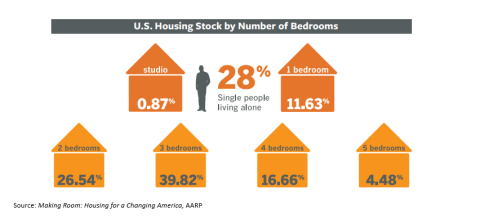America’s housing stock was primarily built for nuclear families, yet fewer and fewer households fit into that category, according to Making Room: Housing for a Changing America, a new report from AARP. The report argues that communities need to create housing that is more affordable and accessible for single-person, senior, and multi-generational households.

Today, nuclear families (two parents and their children) account for just 20 percent of U.S. households. The largest group demographic is single adults who live alone, which at 28 percent, outnumbers nuclear and single-parent families combined. However, America’s housing stock does not reflect the composition of its households. More than 80 percent of the nation’s apartments and houses are built with two, three or four bedrooms, and there are more than twice as many two-bedroom apartments as there are studios and one-bedrooms combined.
This trend is even more pronounced in Vermont, where 30% of households are one-person, yet only 15% of the housing stock is made up of studio or one bedroom apartments or homes, according to 2017 Census Bureau estimates. Increased investment in smaller homes and apartments, which cost less to build, would likely result in more affordable housing choices. Housing is currently unaffordable across most areas of the state. To be able to afford the 2018 median home price of $217,500, a household would need to earn at least $68,635. However, the median household income for Vermonters is just $57,513. Meanwhile, a one bedroom apartment at market rate is not affordable for a worker earning minimum wage in any Vermont county.
The AARP report suggests that overly restrictive zoning laws are responsible for much of the imbalance in the housing stock. Large minimum unit and lot sizes, excessive parking requirements, and expensive permitting processes increase the cost of development, making it difficult for developers to turn a profit on smaller, less expensive houses and apartments.
The report also notes that America’s population of older adults is growing rapidly. By 2030, more than 1 in 5 people in the United States will be age 65 or older. In Vermont, households led by someone age 65 to 74 are the fastest growing demographic group. An AARP survey found that the large majority of older Americans would like to remain in their current homes and communities as long as possible, but most homes in the United States are not designed for aging in place. The report advocates designing more accessible structures, and for communities to promote multigenerational living and home-sharing.
